PROJECT AUDIT, TERMINATION REPORT
VerifiedAdded on 2022/08/23
|14
|2037
|22
AI Summary
Contribute Materials
Your contribution can guide someone’s learning journey. Share your
documents today.
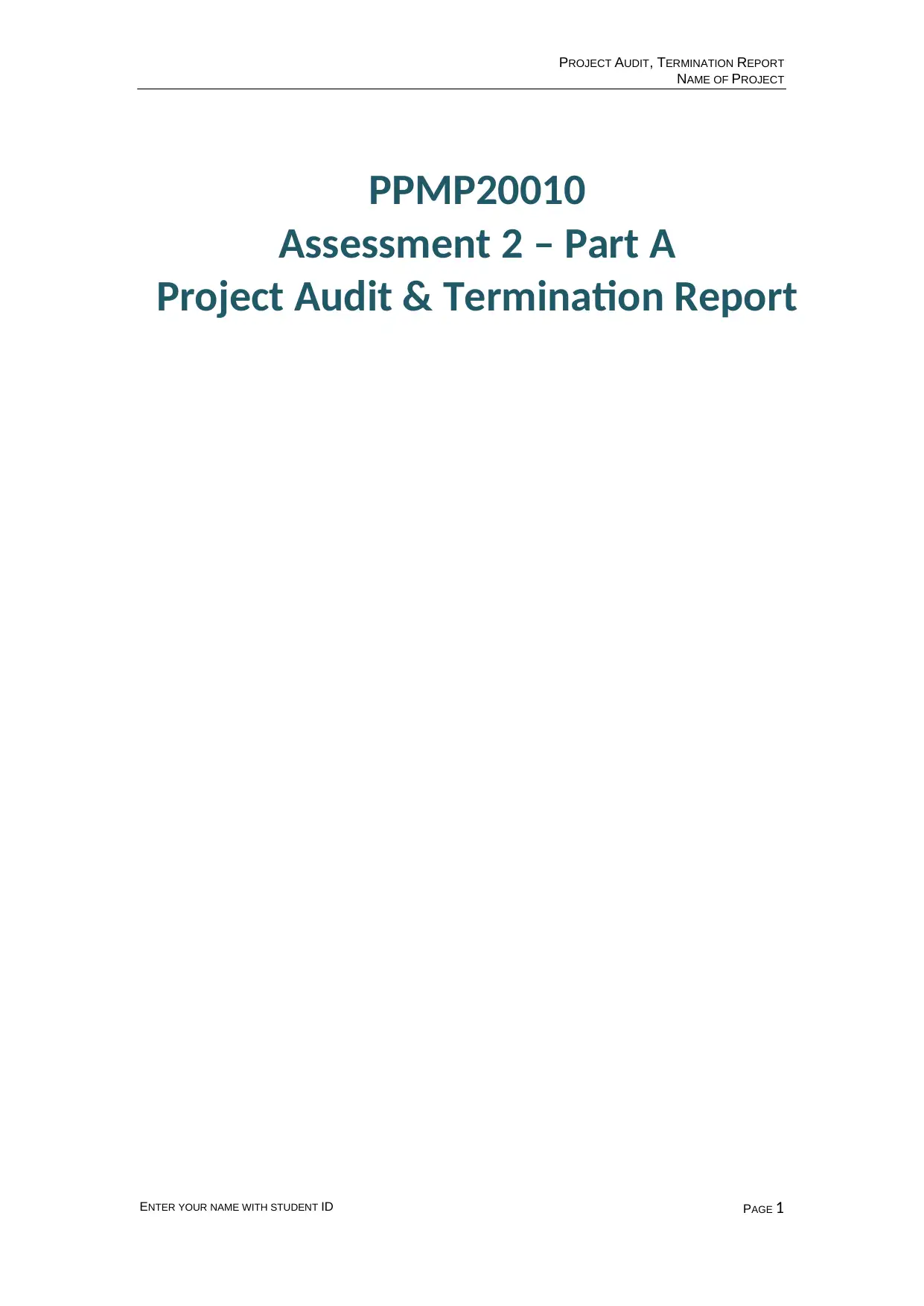
PROJECT AUDIT, TERMINATION REPORT
NAME OF PROJECT
PAGE 1ENTER YOUR NAME WITH STUDENT ID
PPMP20010
Assessment 2 – Part A
Project Audit & Termination Report
NAME OF PROJECT
PAGE 1ENTER YOUR NAME WITH STUDENT ID
PPMP20010
Assessment 2 – Part A
Project Audit & Termination Report
Secure Best Marks with AI Grader
Need help grading? Try our AI Grader for instant feedback on your assignments.
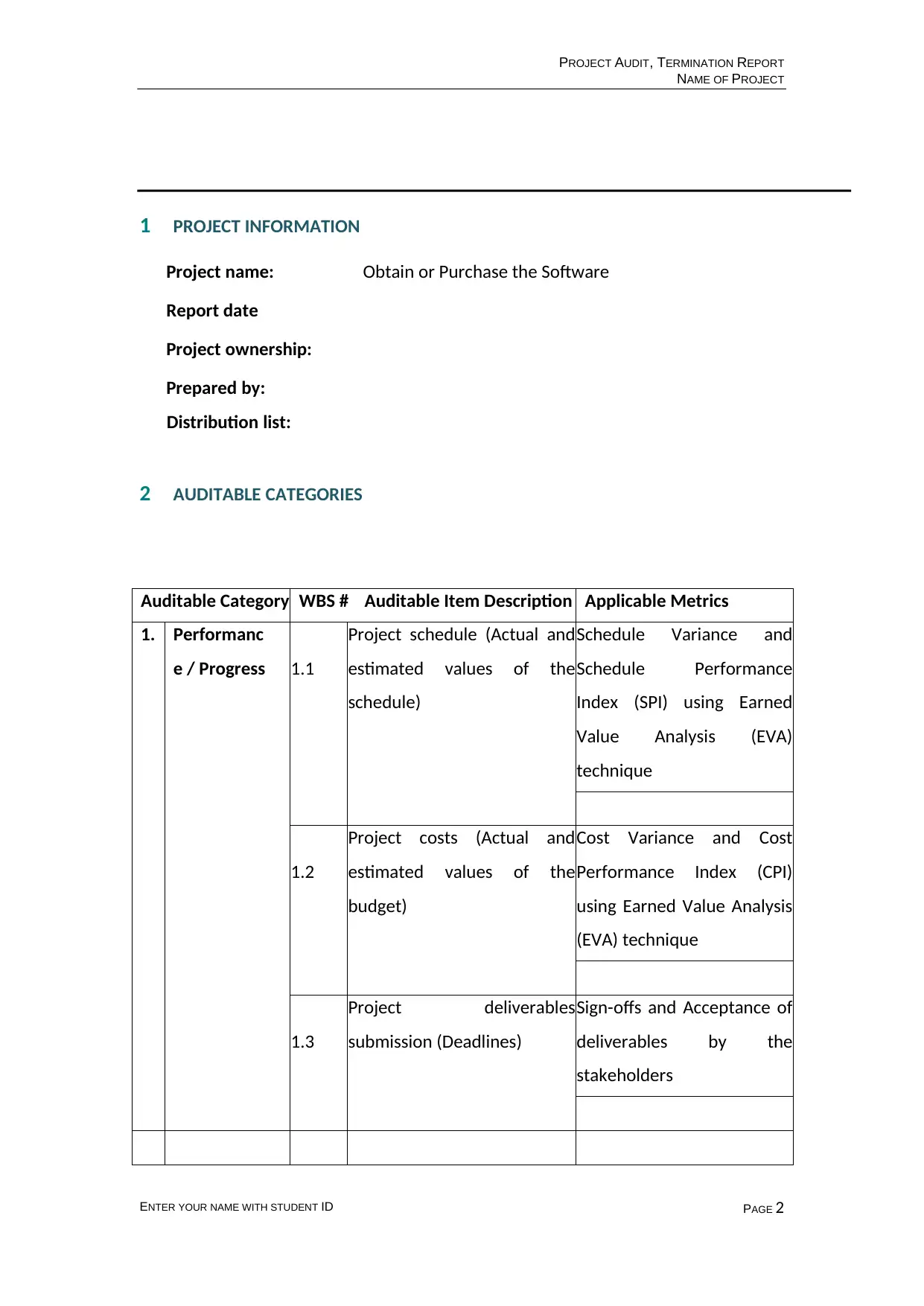
PROJECT AUDIT, TERMINATION REPORT
NAME OF PROJECT
PAGE 2ENTER YOUR NAME WITH STUDENT ID
1 PROJECT INFORMATION
Project name: Obtain or Purchase the Software
Report date
Project ownership:
Prepared by:
Distribution list:
2 AUDITABLE CATEGORIES
Auditable Category WBS # Auditable Item Description Applicable Metrics
1. Performanc
e / Progress 1.1
Project schedule (Actual and
estimated values of the
schedule)
Schedule Variance and
Schedule Performance
Index (SPI) using Earned
Value Analysis (EVA)
technique
1.2
Project costs (Actual and
estimated values of the
budget)
Cost Variance and Cost
Performance Index (CPI)
using Earned Value Analysis
(EVA) technique
1.3
Project deliverables
submission (Deadlines)
Sign-offs and Acceptance of
deliverables by the
stakeholders
NAME OF PROJECT
PAGE 2ENTER YOUR NAME WITH STUDENT ID
1 PROJECT INFORMATION
Project name: Obtain or Purchase the Software
Report date
Project ownership:
Prepared by:
Distribution list:
2 AUDITABLE CATEGORIES
Auditable Category WBS # Auditable Item Description Applicable Metrics
1. Performanc
e / Progress 1.1
Project schedule (Actual and
estimated values of the
schedule)
Schedule Variance and
Schedule Performance
Index (SPI) using Earned
Value Analysis (EVA)
technique
1.2
Project costs (Actual and
estimated values of the
budget)
Cost Variance and Cost
Performance Index (CPI)
using Earned Value Analysis
(EVA) technique
1.3
Project deliverables
submission (Deadlines)
Sign-offs and Acceptance of
deliverables by the
stakeholders
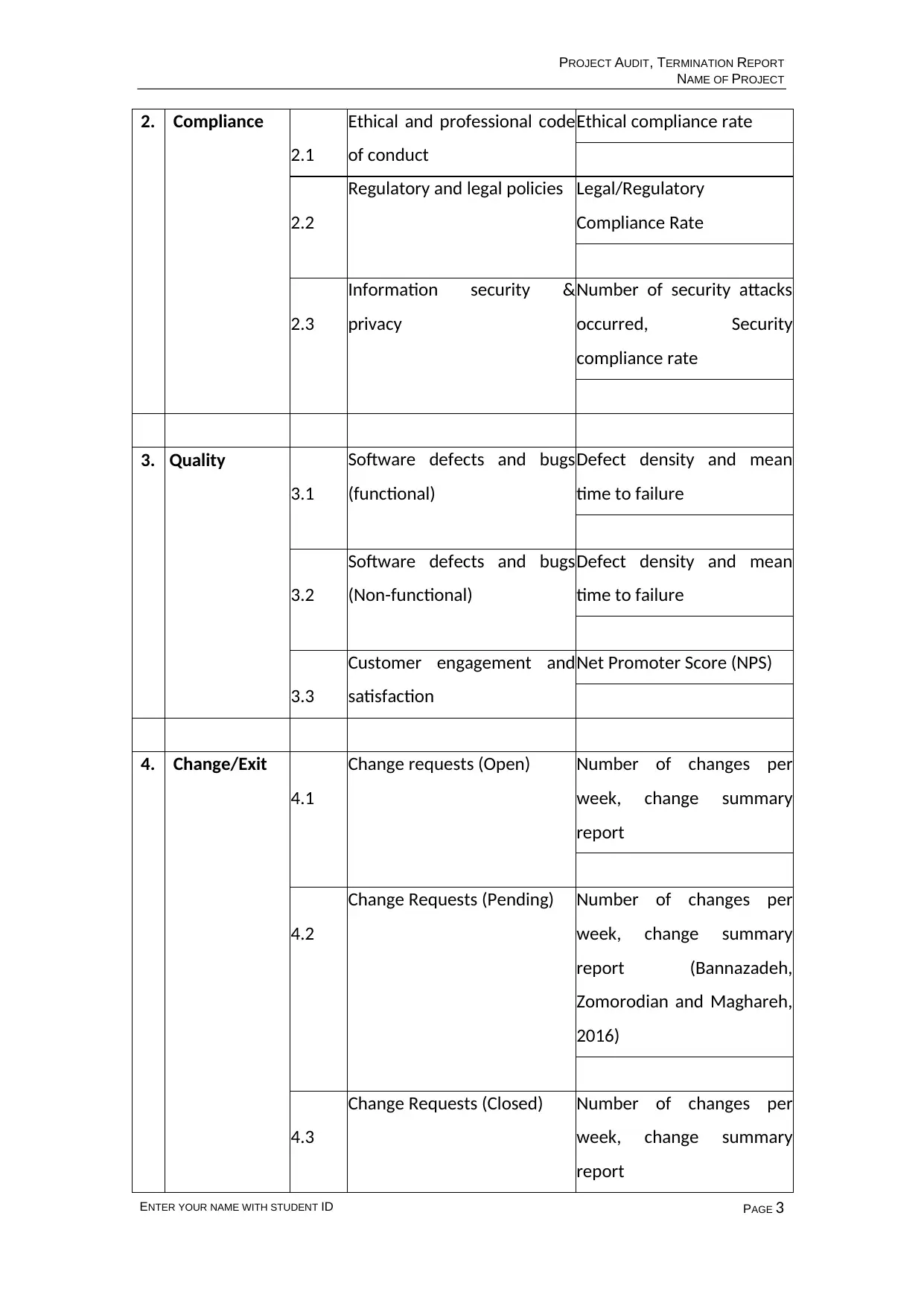
PROJECT AUDIT, TERMINATION REPORT
NAME OF PROJECT
PAGE 3ENTER YOUR NAME WITH STUDENT ID
2. Compliance
2.1
Ethical and professional code
of conduct
Ethical compliance rate
2.2
Regulatory and legal policies Legal/Regulatory
Compliance Rate
2.3
Information security &
privacy
Number of security attacks
occurred, Security
compliance rate
3. Quality
3.1
Software defects and bugs
(functional)
Defect density and mean
time to failure
3.2
Software defects and bugs
(Non-functional)
Defect density and mean
time to failure
3.3
Customer engagement and
satisfaction
Net Promoter Score (NPS)
4. Change/Exit
4.1
Change requests (Open) Number of changes per
week, change summary
report
4.2
Change Requests (Pending) Number of changes per
week, change summary
report (Bannazadeh,
Zomorodian and Maghareh,
2016)
4.3
Change Requests (Closed) Number of changes per
week, change summary
report
NAME OF PROJECT
PAGE 3ENTER YOUR NAME WITH STUDENT ID
2. Compliance
2.1
Ethical and professional code
of conduct
Ethical compliance rate
2.2
Regulatory and legal policies Legal/Regulatory
Compliance Rate
2.3
Information security &
privacy
Number of security attacks
occurred, Security
compliance rate
3. Quality
3.1
Software defects and bugs
(functional)
Defect density and mean
time to failure
3.2
Software defects and bugs
(Non-functional)
Defect density and mean
time to failure
3.3
Customer engagement and
satisfaction
Net Promoter Score (NPS)
4. Change/Exit
4.1
Change requests (Open) Number of changes per
week, change summary
report
4.2
Change Requests (Pending) Number of changes per
week, change summary
report (Bannazadeh,
Zomorodian and Maghareh,
2016)
4.3
Change Requests (Closed) Number of changes per
week, change summary
report
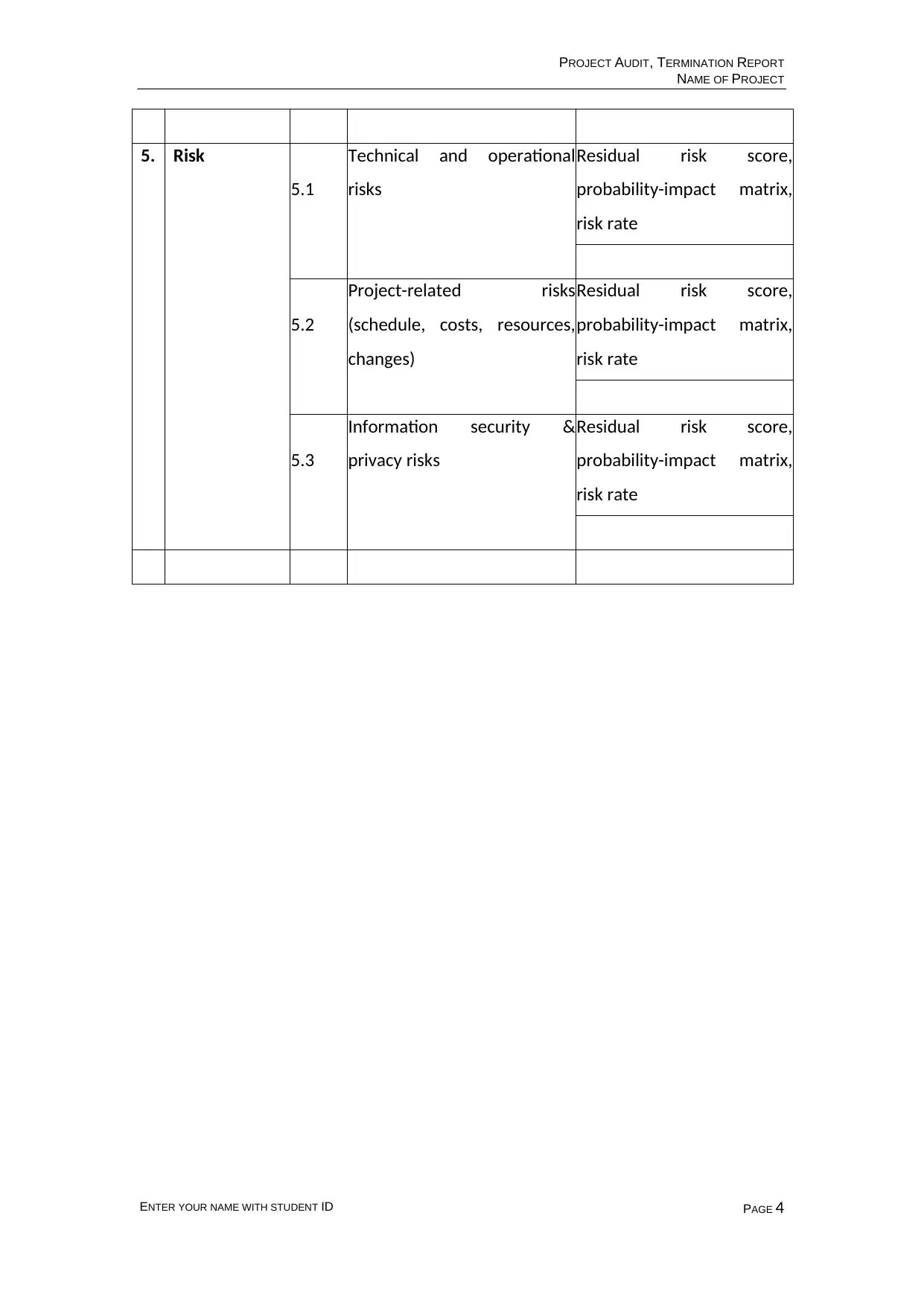
PROJECT AUDIT, TERMINATION REPORT
NAME OF PROJECT
PAGE 4ENTER YOUR NAME WITH STUDENT ID
5. Risk
5.1
Technical and operational
risks
Residual risk score,
probability-impact matrix,
risk rate
5.2
Project-related risks
(schedule, costs, resources,
changes)
Residual risk score,
probability-impact matrix,
risk rate
5.3
Information security &
privacy risks
Residual risk score,
probability-impact matrix,
risk rate
NAME OF PROJECT
PAGE 4ENTER YOUR NAME WITH STUDENT ID
5. Risk
5.1
Technical and operational
risks
Residual risk score,
probability-impact matrix,
risk rate
5.2
Project-related risks
(schedule, costs, resources,
changes)
Residual risk score,
probability-impact matrix,
risk rate
5.3
Information security &
privacy risks
Residual risk score,
probability-impact matrix,
risk rate
Secure Best Marks with AI Grader
Need help grading? Try our AI Grader for instant feedback on your assignments.
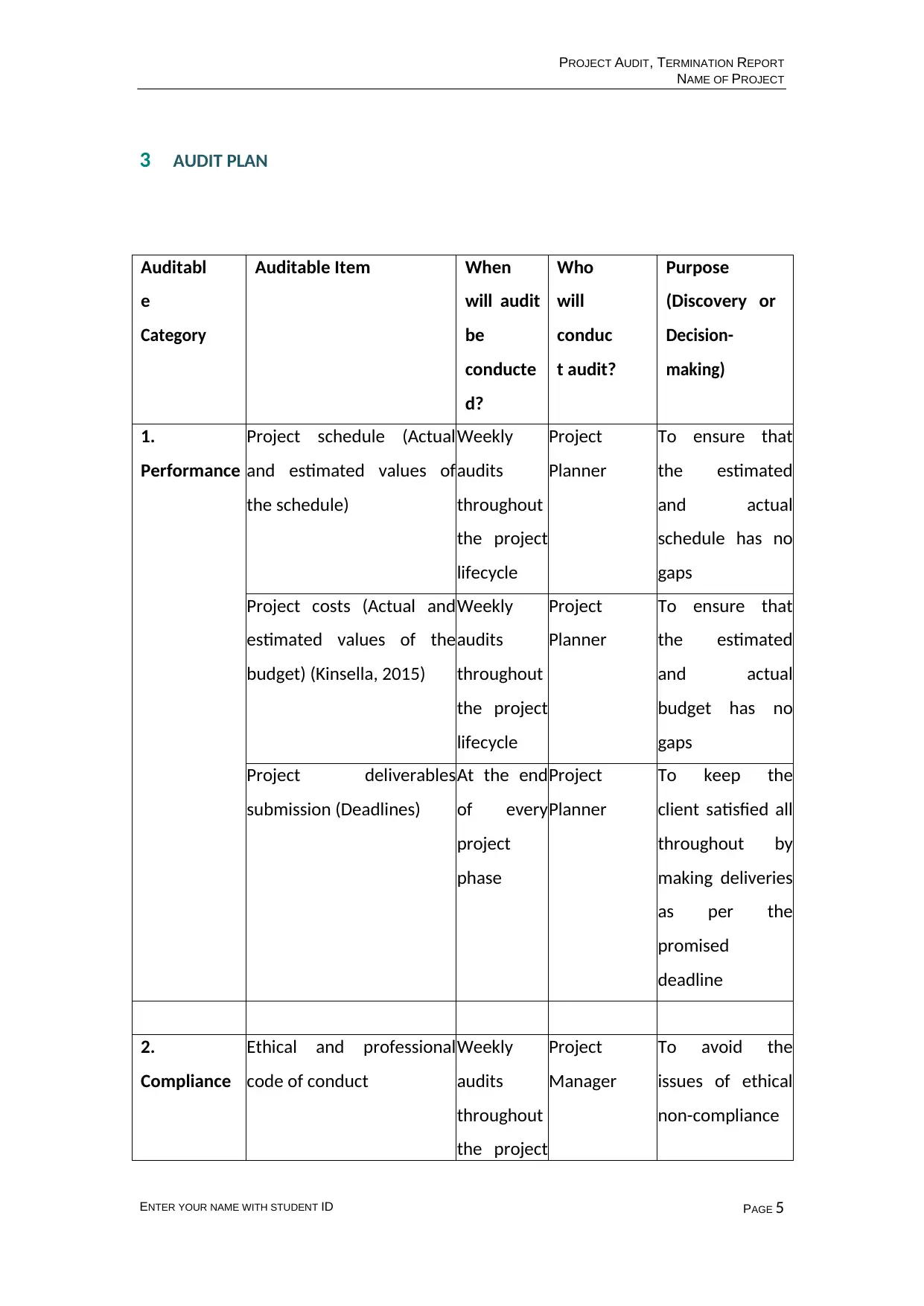
PROJECT AUDIT, TERMINATION REPORT
NAME OF PROJECT
PAGE 5ENTER YOUR NAME WITH STUDENT ID
3 AUDIT PLAN
Auditabl
e
Category
Auditable Item When
will audit
be
conducte
d?
Who
will
conduc
t audit?
Purpose
(Discovery or
Decision-
making)
1.
Performance
Project schedule (Actual
and estimated values of
the schedule)
Weekly
audits
throughout
the project
lifecycle
Project
Planner
To ensure that
the estimated
and actual
schedule has no
gaps
Project costs (Actual and
estimated values of the
budget) (Kinsella, 2015)
Weekly
audits
throughout
the project
lifecycle
Project
Planner
To ensure that
the estimated
and actual
budget has no
gaps
Project deliverables
submission (Deadlines)
At the end
of every
project
phase
Project
Planner
To keep the
client satisfied all
throughout by
making deliveries
as per the
promised
deadline
2.
Compliance
Ethical and professional
code of conduct
Weekly
audits
throughout
the project
Project
Manager
To avoid the
issues of ethical
non-compliance
NAME OF PROJECT
PAGE 5ENTER YOUR NAME WITH STUDENT ID
3 AUDIT PLAN
Auditabl
e
Category
Auditable Item When
will audit
be
conducte
d?
Who
will
conduc
t audit?
Purpose
(Discovery or
Decision-
making)
1.
Performance
Project schedule (Actual
and estimated values of
the schedule)
Weekly
audits
throughout
the project
lifecycle
Project
Planner
To ensure that
the estimated
and actual
schedule has no
gaps
Project costs (Actual and
estimated values of the
budget) (Kinsella, 2015)
Weekly
audits
throughout
the project
lifecycle
Project
Planner
To ensure that
the estimated
and actual
budget has no
gaps
Project deliverables
submission (Deadlines)
At the end
of every
project
phase
Project
Planner
To keep the
client satisfied all
throughout by
making deliveries
as per the
promised
deadline
2.
Compliance
Ethical and professional
code of conduct
Weekly
audits
throughout
the project
Project
Manager
To avoid the
issues of ethical
non-compliance
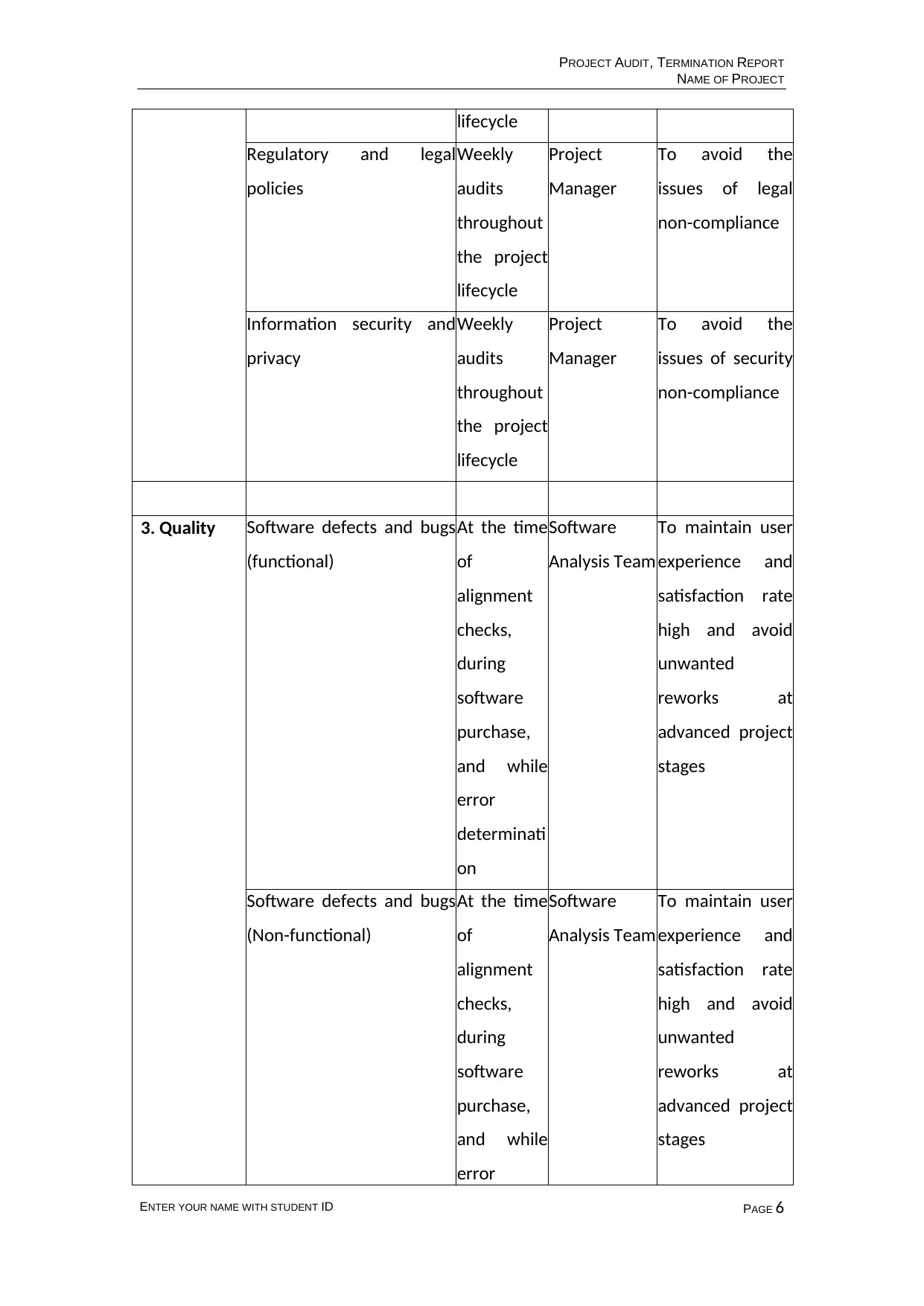
PROJECT AUDIT, TERMINATION REPORT
NAME OF PROJECT
PAGE 6ENTER YOUR NAME WITH STUDENT ID
lifecycle
Regulatory and legal
policies
Weekly
audits
throughout
the project
lifecycle
Project
Manager
To avoid the
issues of legal
non-compliance
Information security and
privacy
Weekly
audits
throughout
the project
lifecycle
Project
Manager
To avoid the
issues of security
non-compliance
3. Quality Software defects and bugs
(functional)
At the time
of
alignment
checks,
during
software
purchase,
and while
error
determinati
on
Software
Analysis Team
To maintain user
experience and
satisfaction rate
high and avoid
unwanted
reworks at
advanced project
stages
Software defects and bugs
(Non-functional)
At the time
of
alignment
checks,
during
software
purchase,
and while
error
Software
Analysis Team
To maintain user
experience and
satisfaction rate
high and avoid
unwanted
reworks at
advanced project
stages
NAME OF PROJECT
PAGE 6ENTER YOUR NAME WITH STUDENT ID
lifecycle
Regulatory and legal
policies
Weekly
audits
throughout
the project
lifecycle
Project
Manager
To avoid the
issues of legal
non-compliance
Information security and
privacy
Weekly
audits
throughout
the project
lifecycle
Project
Manager
To avoid the
issues of security
non-compliance
3. Quality Software defects and bugs
(functional)
At the time
of
alignment
checks,
during
software
purchase,
and while
error
determinati
on
Software
Analysis Team
To maintain user
experience and
satisfaction rate
high and avoid
unwanted
reworks at
advanced project
stages
Software defects and bugs
(Non-functional)
At the time
of
alignment
checks,
during
software
purchase,
and while
error
Software
Analysis Team
To maintain user
experience and
satisfaction rate
high and avoid
unwanted
reworks at
advanced project
stages
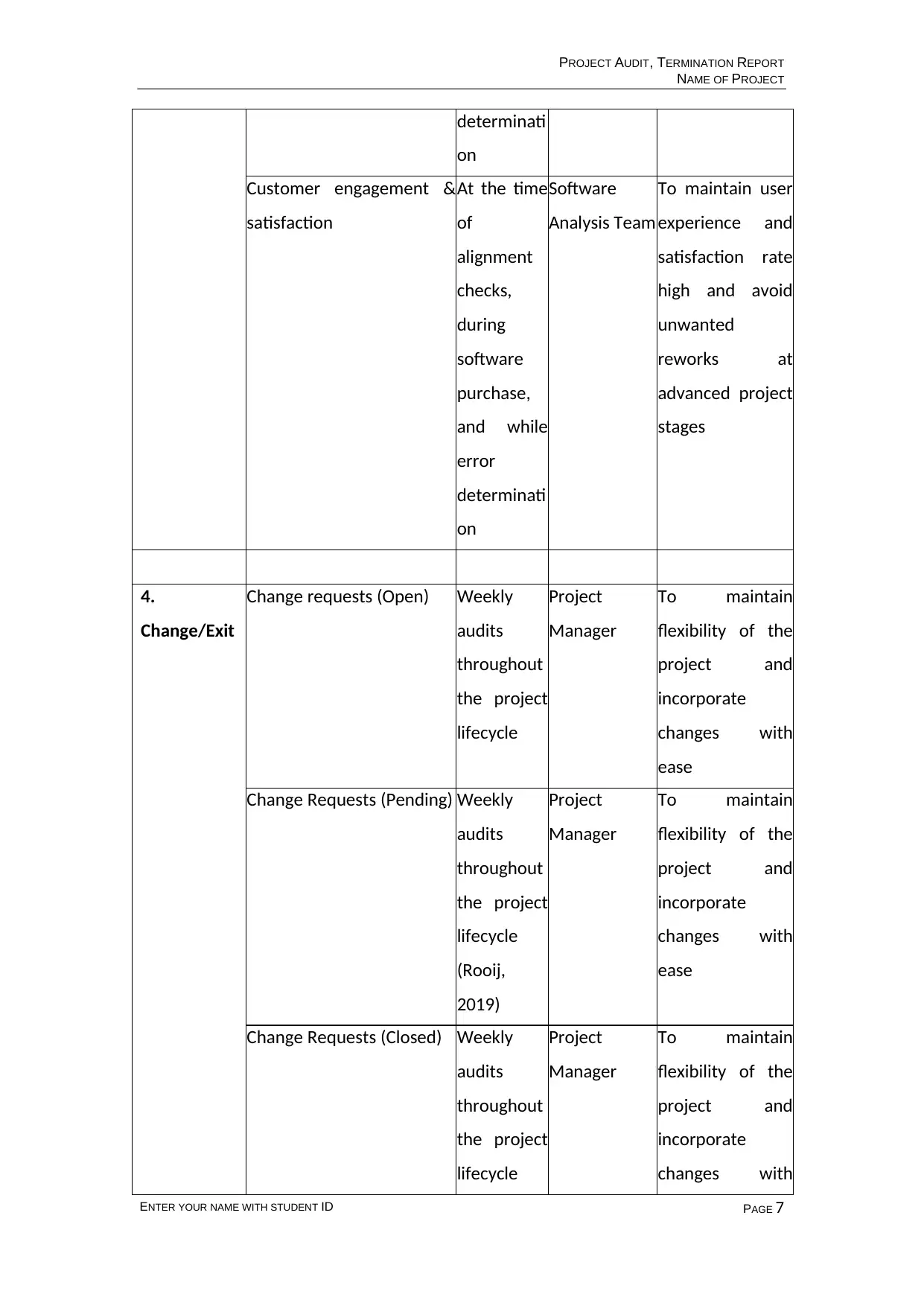
PROJECT AUDIT, TERMINATION REPORT
NAME OF PROJECT
PAGE 7ENTER YOUR NAME WITH STUDENT ID
determinati
on
Customer engagement &
satisfaction
At the time
of
alignment
checks,
during
software
purchase,
and while
error
determinati
on
Software
Analysis Team
To maintain user
experience and
satisfaction rate
high and avoid
unwanted
reworks at
advanced project
stages
4.
Change/Exit
Change requests (Open) Weekly
audits
throughout
the project
lifecycle
Project
Manager
To maintain
flexibility of the
project and
incorporate
changes with
ease
Change Requests (Pending) Weekly
audits
throughout
the project
lifecycle
(Rooij,
2019)
Project
Manager
To maintain
flexibility of the
project and
incorporate
changes with
ease
Change Requests (Closed) Weekly
audits
throughout
the project
lifecycle
Project
Manager
To maintain
flexibility of the
project and
incorporate
changes with
NAME OF PROJECT
PAGE 7ENTER YOUR NAME WITH STUDENT ID
determinati
on
Customer engagement &
satisfaction
At the time
of
alignment
checks,
during
software
purchase,
and while
error
determinati
on
Software
Analysis Team
To maintain user
experience and
satisfaction rate
high and avoid
unwanted
reworks at
advanced project
stages
4.
Change/Exit
Change requests (Open) Weekly
audits
throughout
the project
lifecycle
Project
Manager
To maintain
flexibility of the
project and
incorporate
changes with
ease
Change Requests (Pending) Weekly
audits
throughout
the project
lifecycle
(Rooij,
2019)
Project
Manager
To maintain
flexibility of the
project and
incorporate
changes with
ease
Change Requests (Closed) Weekly
audits
throughout
the project
lifecycle
Project
Manager
To maintain
flexibility of the
project and
incorporate
changes with
Paraphrase This Document
Need a fresh take? Get an instant paraphrase of this document with our AI Paraphraser
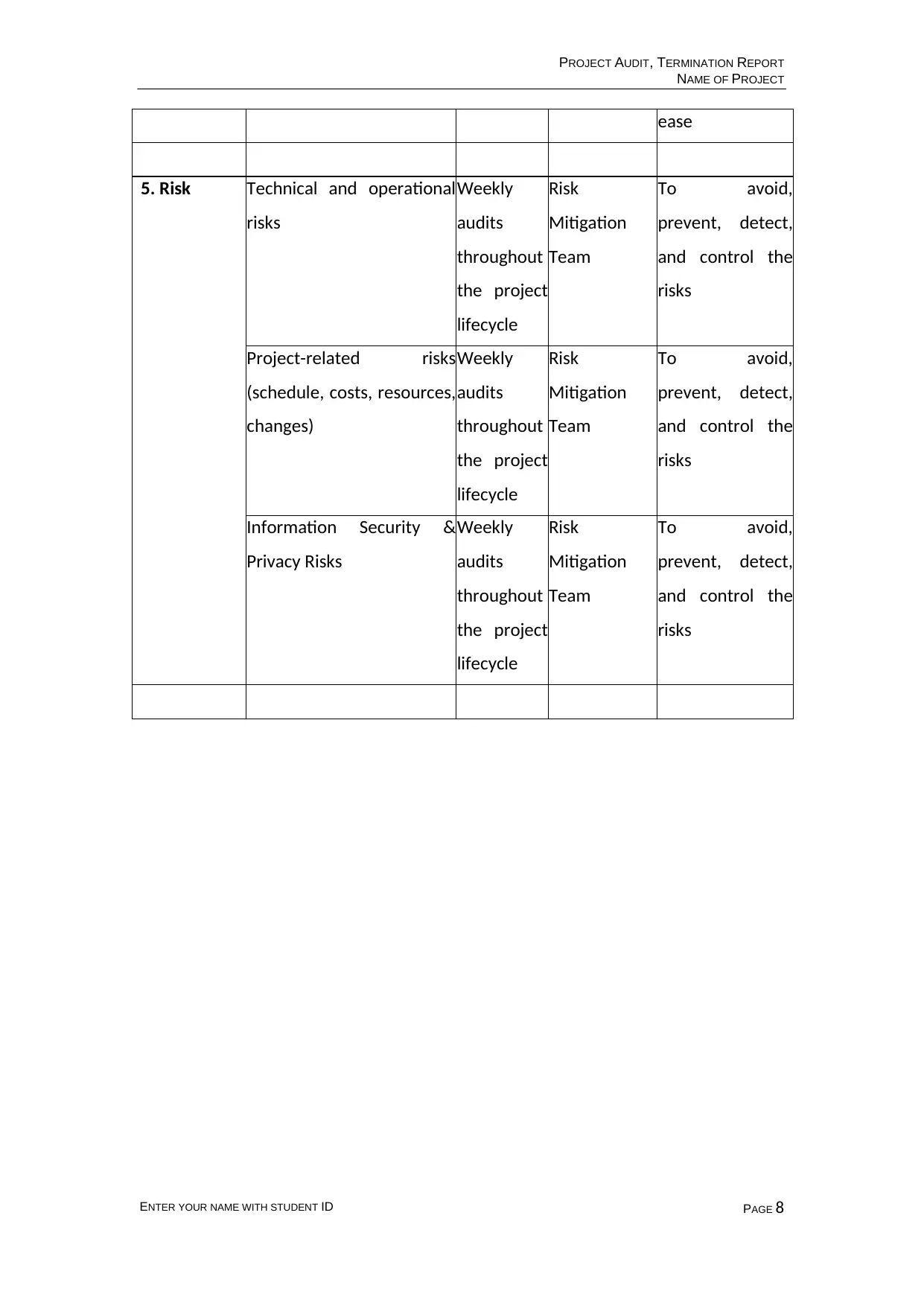
PROJECT AUDIT, TERMINATION REPORT
NAME OF PROJECT
PAGE 8ENTER YOUR NAME WITH STUDENT ID
ease
5. Risk Technical and operational
risks
Weekly
audits
throughout
the project
lifecycle
Risk
Mitigation
Team
To avoid,
prevent, detect,
and control the
risks
Project-related risks
(schedule, costs, resources,
changes)
Weekly
audits
throughout
the project
lifecycle
Risk
Mitigation
Team
To avoid,
prevent, detect,
and control the
risks
Information Security &
Privacy Risks
Weekly
audits
throughout
the project
lifecycle
Risk
Mitigation
Team
To avoid,
prevent, detect,
and control the
risks
NAME OF PROJECT
PAGE 8ENTER YOUR NAME WITH STUDENT ID
ease
5. Risk Technical and operational
risks
Weekly
audits
throughout
the project
lifecycle
Risk
Mitigation
Team
To avoid,
prevent, detect,
and control the
risks
Project-related risks
(schedule, costs, resources,
changes)
Weekly
audits
throughout
the project
lifecycle
Risk
Mitigation
Team
To avoid,
prevent, detect,
and control the
risks
Information Security &
Privacy Risks
Weekly
audits
throughout
the project
lifecycle
Risk
Mitigation
Team
To avoid,
prevent, detect,
and control the
risks
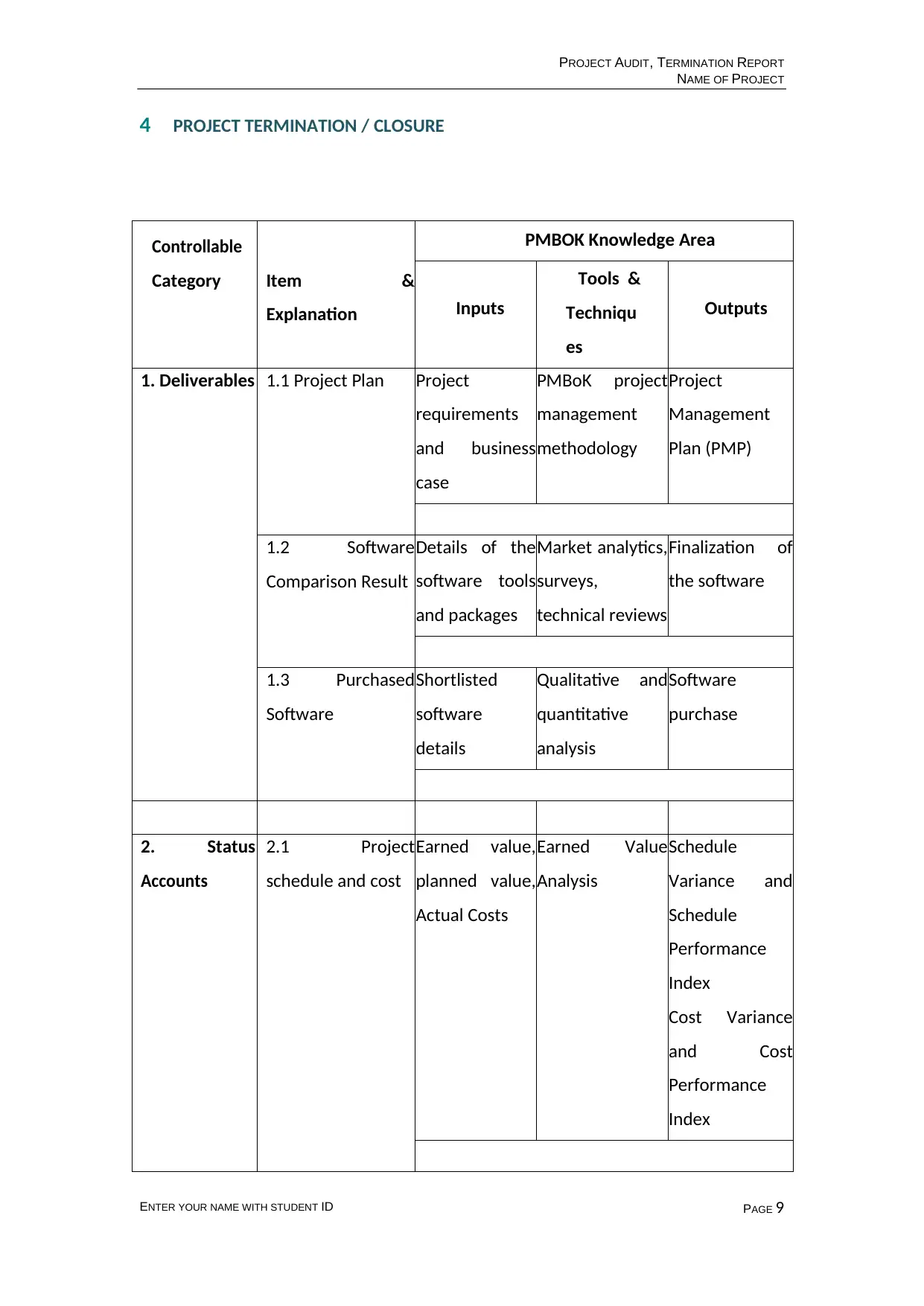
PROJECT AUDIT, TERMINATION REPORT
NAME OF PROJECT
PAGE 9ENTER YOUR NAME WITH STUDENT ID
4 PROJECT TERMINATION / CLOSURE
Controllable
Category Item &
Explanation
PMBOK Knowledge Area
Inputs
Tools &
Techniqu
es
Outputs
1. Deliverables 1.1 Project Plan Project
requirements
and business
case
PMBoK project
management
methodology
Project
Management
Plan (PMP)
1.2 Software
Comparison Result
Details of the
software tools
and packages
Market analytics,
surveys,
technical reviews
Finalization of
the software
1.3 Purchased
Software
Shortlisted
software
details
Qualitative and
quantitative
analysis
Software
purchase
2. Status
Accounts
2.1 Project
schedule and cost
Earned value,
planned value,
Actual Costs
Earned Value
Analysis
Schedule
Variance and
Schedule
Performance
Index
Cost Variance
and Cost
Performance
Index
NAME OF PROJECT
PAGE 9ENTER YOUR NAME WITH STUDENT ID
4 PROJECT TERMINATION / CLOSURE
Controllable
Category Item &
Explanation
PMBOK Knowledge Area
Inputs
Tools &
Techniqu
es
Outputs
1. Deliverables 1.1 Project Plan Project
requirements
and business
case
PMBoK project
management
methodology
Project
Management
Plan (PMP)
1.2 Software
Comparison Result
Details of the
software tools
and packages
Market analytics,
surveys,
technical reviews
Finalization of
the software
1.3 Purchased
Software
Shortlisted
software
details
Qualitative and
quantitative
analysis
Software
purchase
2. Status
Accounts
2.1 Project
schedule and cost
Earned value,
planned value,
Actual Costs
Earned Value
Analysis
Schedule
Variance and
Schedule
Performance
Index
Cost Variance
and Cost
Performance
Index
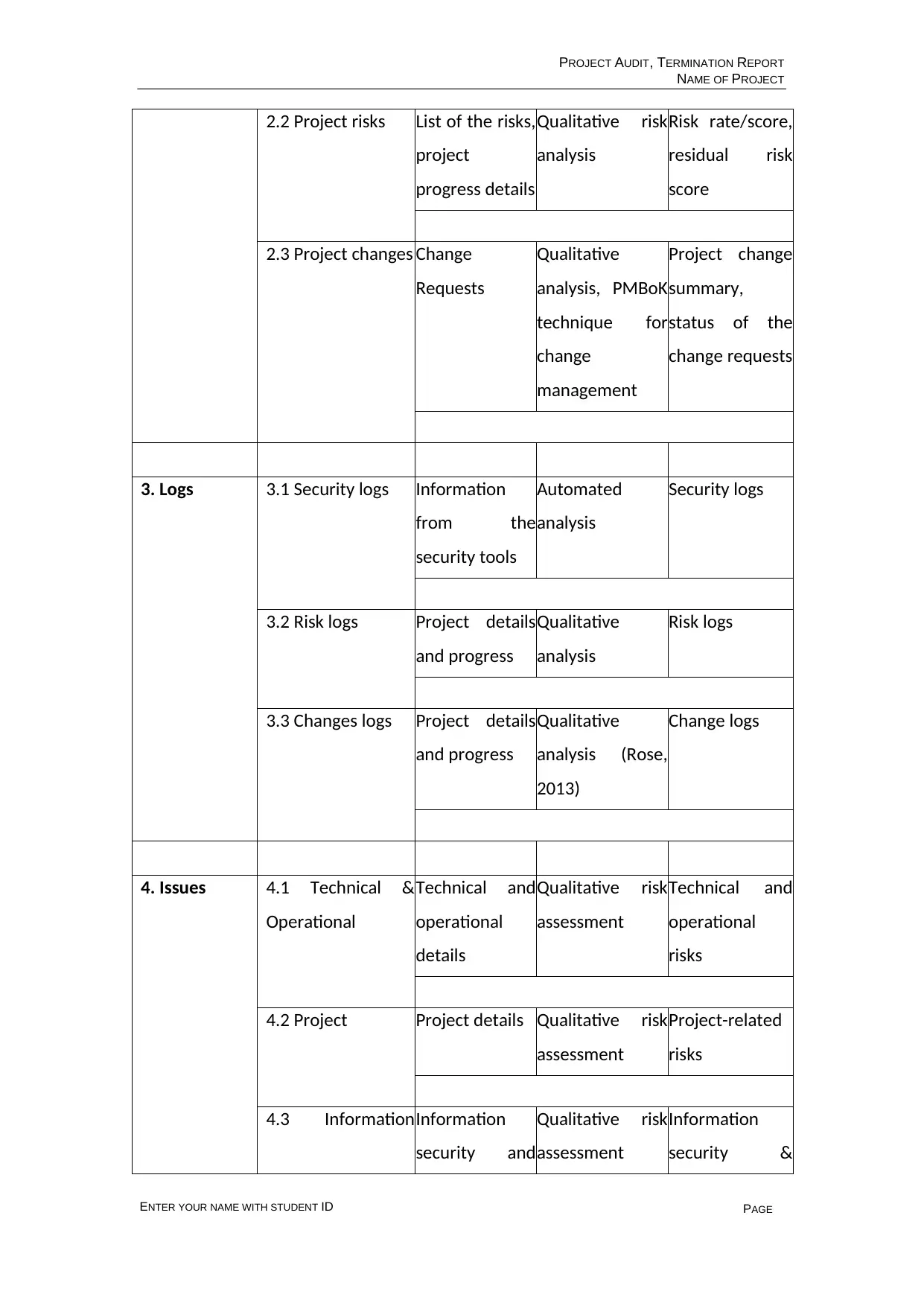
PROJECT AUDIT, TERMINATION REPORT
NAME OF PROJECT
PAGEENTER YOUR NAME WITH STUDENT ID
2.2 Project risks List of the risks,
project
progress details
Qualitative risk
analysis
Risk rate/score,
residual risk
score
2.3 Project changes Change
Requests
Qualitative
analysis, PMBoK
technique for
change
management
Project change
summary,
status of the
change requests
3. Logs 3.1 Security logs Information
from the
security tools
Automated
analysis
Security logs
3.2 Risk logs Project details
and progress
Qualitative
analysis
Risk logs
3.3 Changes logs Project details
and progress
Qualitative
analysis (Rose,
2013)
Change logs
4. Issues 4.1 Technical &
Operational
Technical and
operational
details
Qualitative risk
assessment
Technical and
operational
risks
4.2 Project Project details Qualitative risk
assessment
Project-related
risks
4.3 InformationInformation
security and
Qualitative risk
assessment
Information
security &
NAME OF PROJECT
PAGEENTER YOUR NAME WITH STUDENT ID
2.2 Project risks List of the risks,
project
progress details
Qualitative risk
analysis
Risk rate/score,
residual risk
score
2.3 Project changes Change
Requests
Qualitative
analysis, PMBoK
technique for
change
management
Project change
summary,
status of the
change requests
3. Logs 3.1 Security logs Information
from the
security tools
Automated
analysis
Security logs
3.2 Risk logs Project details
and progress
Qualitative
analysis
Risk logs
3.3 Changes logs Project details
and progress
Qualitative
analysis (Rose,
2013)
Change logs
4. Issues 4.1 Technical &
Operational
Technical and
operational
details
Qualitative risk
assessment
Technical and
operational
risks
4.2 Project Project details Qualitative risk
assessment
Project-related
risks
4.3 InformationInformation
security and
Qualitative risk
assessment
Information
security &
Secure Best Marks with AI Grader
Need help grading? Try our AI Grader for instant feedback on your assignments.
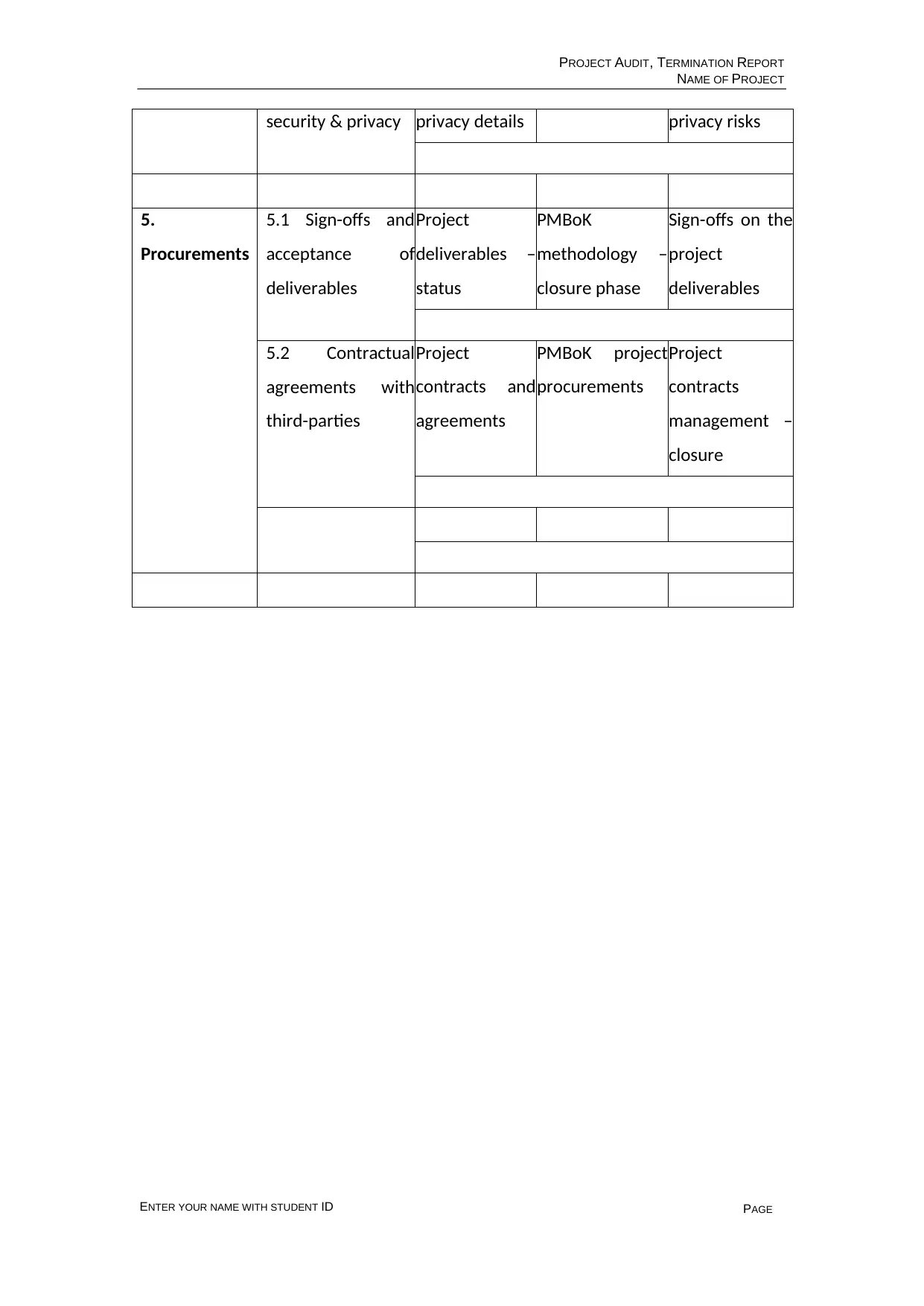
PROJECT AUDIT, TERMINATION REPORT
NAME OF PROJECT
PAGEENTER YOUR NAME WITH STUDENT ID
security & privacy privacy details privacy risks
5.
Procurements
5.1 Sign-offs and
acceptance of
deliverables
Project
deliverables –
status
PMBoK
methodology –
closure phase
Sign-offs on the
project
deliverables
5.2 Contractual
agreements with
third-parties
Project
contracts and
agreements
PMBoK project
procurements
Project
contracts
management –
closure
NAME OF PROJECT
PAGEENTER YOUR NAME WITH STUDENT ID
security & privacy privacy details privacy risks
5.
Procurements
5.1 Sign-offs and
acceptance of
deliverables
Project
deliverables –
status
PMBoK
methodology –
closure phase
Sign-offs on the
project
deliverables
5.2 Contractual
agreements with
third-parties
Project
contracts and
agreements
PMBoK project
procurements
Project
contracts
management –
closure
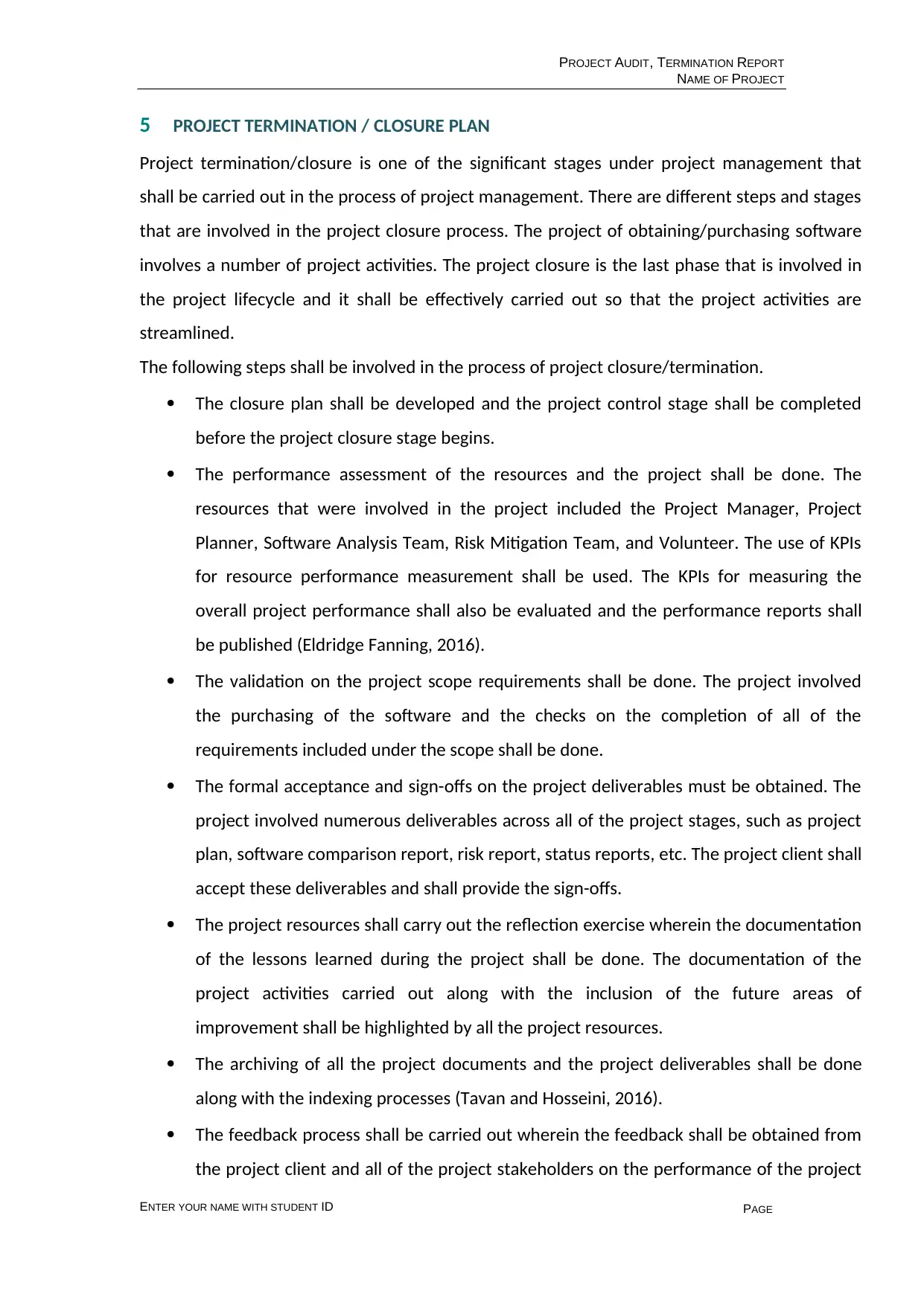
PROJECT AUDIT, TERMINATION REPORT
NAME OF PROJECT
PAGEENTER YOUR NAME WITH STUDENT ID
5 PROJECT TERMINATION / CLOSURE PLAN
Project termination/closure is one of the significant stages under project management that
shall be carried out in the process of project management. There are different steps and stages
that are involved in the project closure process. The project of obtaining/purchasing software
involves a number of project activities. The project closure is the last phase that is involved in
the project lifecycle and it shall be effectively carried out so that the project activities are
streamlined.
The following steps shall be involved in the process of project closure/termination.
The closure plan shall be developed and the project control stage shall be completed
before the project closure stage begins.
The performance assessment of the resources and the project shall be done. The
resources that were involved in the project included the Project Manager, Project
Planner, Software Analysis Team, Risk Mitigation Team, and Volunteer. The use of KPIs
for resource performance measurement shall be used. The KPIs for measuring the
overall project performance shall also be evaluated and the performance reports shall
be published (Eldridge Fanning, 2016).
The validation on the project scope requirements shall be done. The project involved
the purchasing of the software and the checks on the completion of all of the
requirements included under the scope shall be done.
The formal acceptance and sign-offs on the project deliverables must be obtained. The
project involved numerous deliverables across all of the project stages, such as project
plan, software comparison report, risk report, status reports, etc. The project client shall
accept these deliverables and shall provide the sign-offs.
The project resources shall carry out the reflection exercise wherein the documentation
of the lessons learned during the project shall be done. The documentation of the
project activities carried out along with the inclusion of the future areas of
improvement shall be highlighted by all the project resources.
The archiving of all the project documents and the project deliverables shall be done
along with the indexing processes (Tavan and Hosseini, 2016).
The feedback process shall be carried out wherein the feedback shall be obtained from
the project client and all of the project stakeholders on the performance of the project
NAME OF PROJECT
PAGEENTER YOUR NAME WITH STUDENT ID
5 PROJECT TERMINATION / CLOSURE PLAN
Project termination/closure is one of the significant stages under project management that
shall be carried out in the process of project management. There are different steps and stages
that are involved in the project closure process. The project of obtaining/purchasing software
involves a number of project activities. The project closure is the last phase that is involved in
the project lifecycle and it shall be effectively carried out so that the project activities are
streamlined.
The following steps shall be involved in the process of project closure/termination.
The closure plan shall be developed and the project control stage shall be completed
before the project closure stage begins.
The performance assessment of the resources and the project shall be done. The
resources that were involved in the project included the Project Manager, Project
Planner, Software Analysis Team, Risk Mitigation Team, and Volunteer. The use of KPIs
for resource performance measurement shall be used. The KPIs for measuring the
overall project performance shall also be evaluated and the performance reports shall
be published (Eldridge Fanning, 2016).
The validation on the project scope requirements shall be done. The project involved
the purchasing of the software and the checks on the completion of all of the
requirements included under the scope shall be done.
The formal acceptance and sign-offs on the project deliverables must be obtained. The
project involved numerous deliverables across all of the project stages, such as project
plan, software comparison report, risk report, status reports, etc. The project client shall
accept these deliverables and shall provide the sign-offs.
The project resources shall carry out the reflection exercise wherein the documentation
of the lessons learned during the project shall be done. The documentation of the
project activities carried out along with the inclusion of the future areas of
improvement shall be highlighted by all the project resources.
The archiving of all the project documents and the project deliverables shall be done
along with the indexing processes (Tavan and Hosseini, 2016).
The feedback process shall be carried out wherein the feedback shall be obtained from
the project client and all of the project stakeholders on the performance of the project
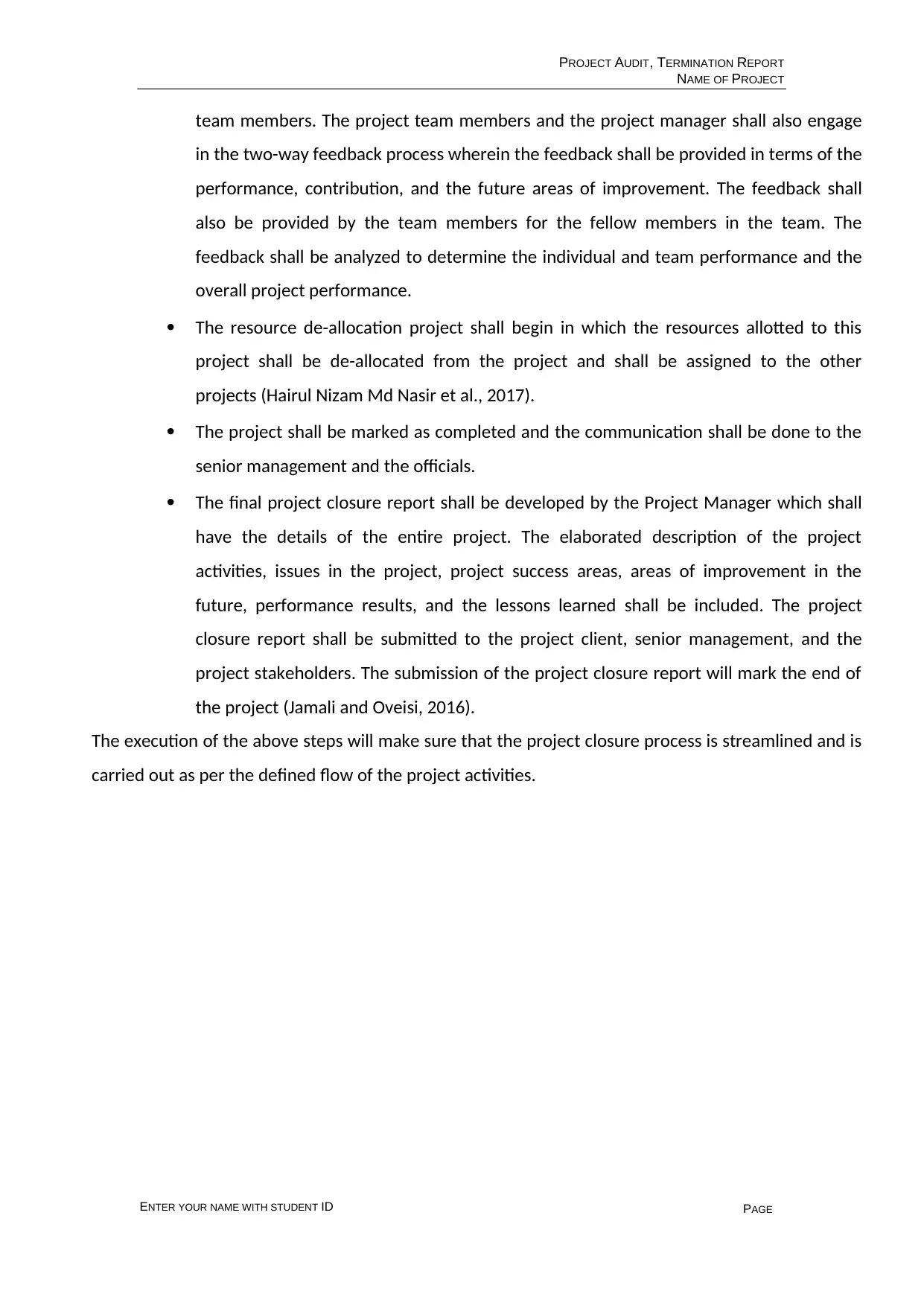
PROJECT AUDIT, TERMINATION REPORT
NAME OF PROJECT
PAGEENTER YOUR NAME WITH STUDENT ID
team members. The project team members and the project manager shall also engage
in the two-way feedback process wherein the feedback shall be provided in terms of the
performance, contribution, and the future areas of improvement. The feedback shall
also be provided by the team members for the fellow members in the team. The
feedback shall be analyzed to determine the individual and team performance and the
overall project performance.
The resource de-allocation project shall begin in which the resources allotted to this
project shall be de-allocated from the project and shall be assigned to the other
projects (Hairul Nizam Md Nasir et al., 2017).
The project shall be marked as completed and the communication shall be done to the
senior management and the officials.
The final project closure report shall be developed by the Project Manager which shall
have the details of the entire project. The elaborated description of the project
activities, issues in the project, project success areas, areas of improvement in the
future, performance results, and the lessons learned shall be included. The project
closure report shall be submitted to the project client, senior management, and the
project stakeholders. The submission of the project closure report will mark the end of
the project (Jamali and Oveisi, 2016).
The execution of the above steps will make sure that the project closure process is streamlined and is
carried out as per the defined flow of the project activities.
NAME OF PROJECT
PAGEENTER YOUR NAME WITH STUDENT ID
team members. The project team members and the project manager shall also engage
in the two-way feedback process wherein the feedback shall be provided in terms of the
performance, contribution, and the future areas of improvement. The feedback shall
also be provided by the team members for the fellow members in the team. The
feedback shall be analyzed to determine the individual and team performance and the
overall project performance.
The resource de-allocation project shall begin in which the resources allotted to this
project shall be de-allocated from the project and shall be assigned to the other
projects (Hairul Nizam Md Nasir et al., 2017).
The project shall be marked as completed and the communication shall be done to the
senior management and the officials.
The final project closure report shall be developed by the Project Manager which shall
have the details of the entire project. The elaborated description of the project
activities, issues in the project, project success areas, areas of improvement in the
future, performance results, and the lessons learned shall be included. The project
closure report shall be submitted to the project client, senior management, and the
project stakeholders. The submission of the project closure report will mark the end of
the project (Jamali and Oveisi, 2016).
The execution of the above steps will make sure that the project closure process is streamlined and is
carried out as per the defined flow of the project activities.
Paraphrase This Document
Need a fresh take? Get an instant paraphrase of this document with our AI Paraphraser
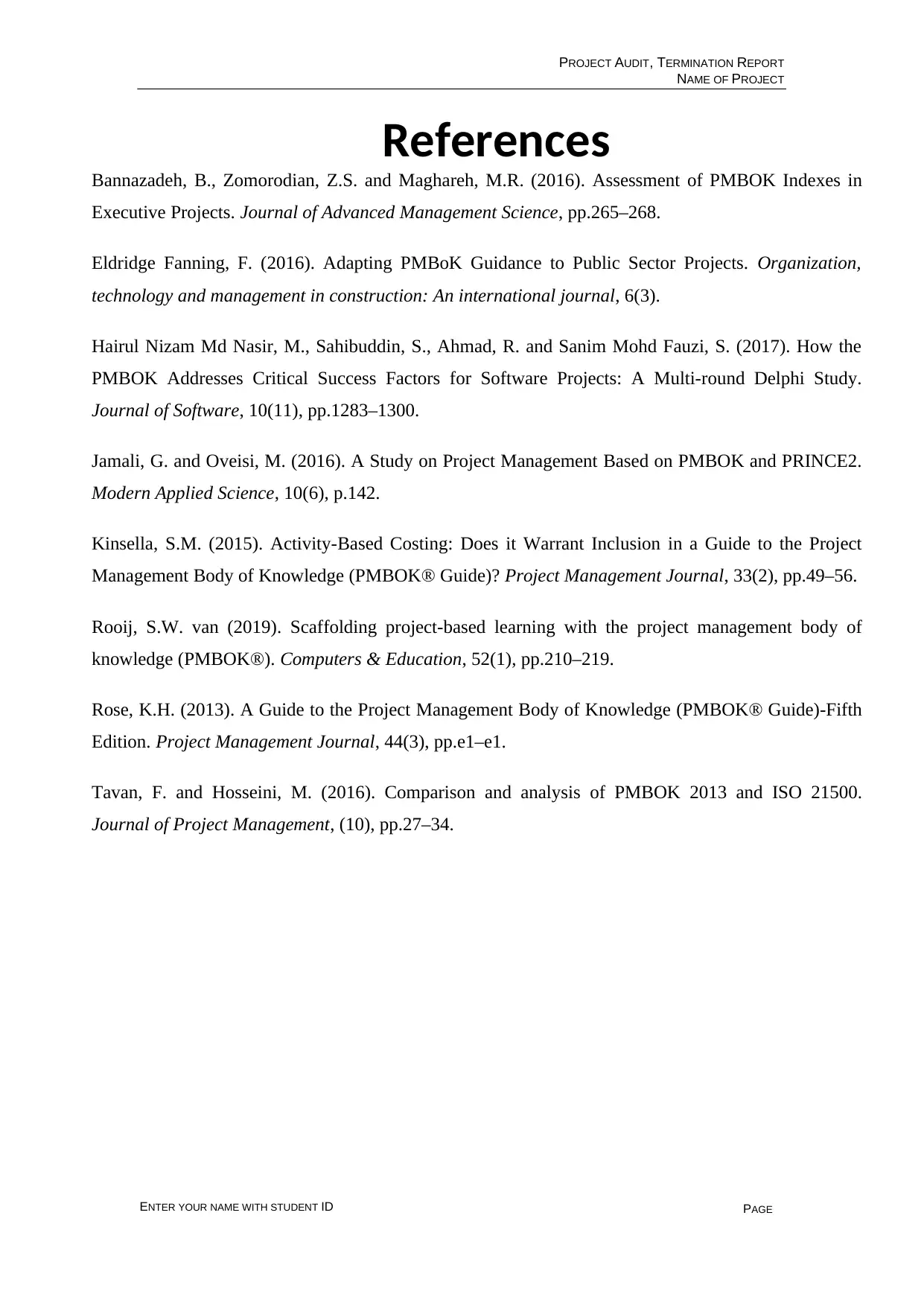
PROJECT AUDIT, TERMINATION REPORT
NAME OF PROJECT
PAGEENTER YOUR NAME WITH STUDENT ID
References
Bannazadeh, B., Zomorodian, Z.S. and Maghareh, M.R. (2016). Assessment of PMBOK Indexes in
Executive Projects. Journal of Advanced Management Science, pp.265–268.
Eldridge Fanning, F. (2016). Adapting PMBoK Guidance to Public Sector Projects. Organization,
technology and management in construction: An international journal, 6(3).
Hairul Nizam Md Nasir, M., Sahibuddin, S., Ahmad, R. and Sanim Mohd Fauzi, S. (2017). How the
PMBOK Addresses Critical Success Factors for Software Projects: A Multi-round Delphi Study.
Journal of Software, 10(11), pp.1283–1300.
Jamali, G. and Oveisi, M. (2016). A Study on Project Management Based on PMBOK and PRINCE2.
Modern Applied Science, 10(6), p.142.
Kinsella, S.M. (2015). Activity-Based Costing: Does it Warrant Inclusion in a Guide to the Project
Management Body of Knowledge (PMBOK® Guide)? Project Management Journal, 33(2), pp.49–56.
Rooij, S.W. van (2019). Scaffolding project-based learning with the project management body of
knowledge (PMBOK®). Computers & Education, 52(1), pp.210–219.
Rose, K.H. (2013). A Guide to the Project Management Body of Knowledge (PMBOK® Guide)-Fifth
Edition. Project Management Journal, 44(3), pp.e1–e1.
Tavan, F. and Hosseini, M. (2016). Comparison and analysis of PMBOK 2013 and ISO 21500.
Journal of Project Management, (10), pp.27–34.
NAME OF PROJECT
PAGEENTER YOUR NAME WITH STUDENT ID
References
Bannazadeh, B., Zomorodian, Z.S. and Maghareh, M.R. (2016). Assessment of PMBOK Indexes in
Executive Projects. Journal of Advanced Management Science, pp.265–268.
Eldridge Fanning, F. (2016). Adapting PMBoK Guidance to Public Sector Projects. Organization,
technology and management in construction: An international journal, 6(3).
Hairul Nizam Md Nasir, M., Sahibuddin, S., Ahmad, R. and Sanim Mohd Fauzi, S. (2017). How the
PMBOK Addresses Critical Success Factors for Software Projects: A Multi-round Delphi Study.
Journal of Software, 10(11), pp.1283–1300.
Jamali, G. and Oveisi, M. (2016). A Study on Project Management Based on PMBOK and PRINCE2.
Modern Applied Science, 10(6), p.142.
Kinsella, S.M. (2015). Activity-Based Costing: Does it Warrant Inclusion in a Guide to the Project
Management Body of Knowledge (PMBOK® Guide)? Project Management Journal, 33(2), pp.49–56.
Rooij, S.W. van (2019). Scaffolding project-based learning with the project management body of
knowledge (PMBOK®). Computers & Education, 52(1), pp.210–219.
Rose, K.H. (2013). A Guide to the Project Management Body of Knowledge (PMBOK® Guide)-Fifth
Edition. Project Management Journal, 44(3), pp.e1–e1.
Tavan, F. and Hosseini, M. (2016). Comparison and analysis of PMBOK 2013 and ISO 21500.
Journal of Project Management, (10), pp.27–34.
1 out of 14
Your All-in-One AI-Powered Toolkit for Academic Success.
+13062052269
info@desklib.com
Available 24*7 on WhatsApp / Email
![[object Object]](/_next/static/media/star-bottom.7253800d.svg)
Unlock your academic potential
© 2024 | Zucol Services PVT LTD | All rights reserved.